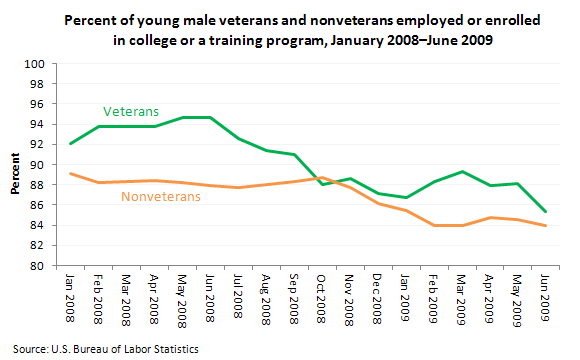June 22, 2012 (The Editor’s Desk is updated each business day.)
Employment and enrollment of young male veterans in the 2007–2009 recession
In 2007, nearly 1.5 million veterans had served in the United States Armed Forces since September 2001. By the end of 2007, the United States began a long recession, in which young workers faced particularly large employment losses. The chart compares the employment, educational, and training experiences of young male veterans and nonveterans during the January 2008–June 2009 time period, which coincides with the recession that began in December 2007 and continued through June 2009.

[Chart data]
The percent of veterans employed or enrolled in college or training remained above the percent of nonveterans employed or enrolled from January 2008 through September 2008; the percent of veterans trended downward during that period, whereas the nonveteran percent remained mostly flat. After September 2008, the two groups moved together in a downward trend until January 2009. Starting in that month, the percent of veterans employed or enrolled in college or training generally rose, while the percent of nonveterans remained fairly flat. Veterans were more likely than nonveterans to be enrolled in college or a training program over the January 2008–June 2009 period. Many of the veterans were simultaneously employed and enrolled in college or training.
These data are from the National Longitudinal Surveys program. To learn more, see “Employment, college enrollment, and training of young male veterans and nonveterans during the recent recession,” (HTML) (PDF) by Donna Rothstein, in an issue of Beyond the Numbers published in June 2012. The data are from the National Longitudinal Survey of Youth 1997, a nationally representative sample of men and women who were born in the years 1980 to 1984 and living in the United States at the time of the initial survey. Survey participants were first interviewed in 1997 when they were ages 12 to 17 and have been interviewed annually. Survey participants turned 24 to 28 years old in 2008. Veterans in the analysis are defined as those who had served in the military and were not on active duty at any point during the January 2008–June 2009 period. Nonveterans are defined as those who never served in the military.
Related TED articles
Education and Training |
Employment |
Men |
Youth
Of interest
Spotlight on Statistics: National Hispanic Heritage Month
In this Spotlight, we take a look at the Hispanic labor force—including labor force participation, employment and unemployment, educational attainment, geographic location, country of birth, earnings, consumer expenditures, time use, workplace injuries, and employment projections.
.
Read more »
